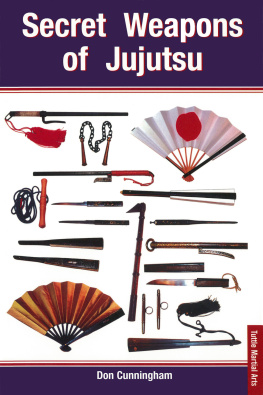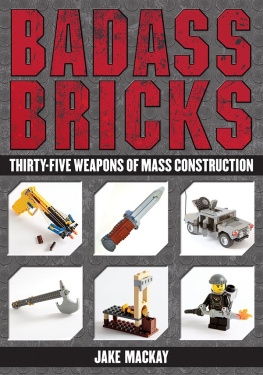Cunningham Don. - Secret Weapons of Jujutsu
Here you can read online Cunningham Don. - Secret Weapons of Jujutsu full text of the book (entire story) in english for free. Download pdf and epub, get meaning, cover and reviews about this ebook. genre: Science. Description of the work, (preface) as well as reviews are available. Best literature library LitArk.com created for fans of good reading and offers a wide selection of genres:
Romance novel
Science fiction
Adventure
Detective
Science
History
Home and family
Prose
Art
Politics
Computer
Non-fiction
Religion
Business
Children
Humor
Choose a favorite category and find really read worthwhile books. Enjoy immersion in the world of imagination, feel the emotions of the characters or learn something new for yourself, make an fascinating discovery.
- Book:Secret Weapons of Jujutsu
- Author:
- Genre:
- Rating:3 / 5
- Favourites:Add to favourites
- Your mark:
- 60
- 1
- 2
- 3
- 4
- 5
Secret Weapons of Jujutsu: summary, description and annotation
We offer to read an annotation, description, summary or preface (depends on what the author of the book "Secret Weapons of Jujutsu" wrote himself). If you haven't found the necessary information about the book — write in the comments, we will try to find it.
Secret Weapons of Jujutsu — read online for free the complete book (whole text) full work
Below is the text of the book, divided by pages. System saving the place of the last page read, allows you to conveniently read the book "Secret Weapons of Jujutsu" online for free, without having to search again every time where you left off. Put a bookmark, and you can go to the page where you finished reading at any time.
Font size:
Interval:
Bookmark:
CHAPTER 1 | Development of |
The Japanese sword, admired for its artistic value as well as for its practical merits, is often considered an emblem of the samurais power and skill. It was venerated by the bushi, or warrior class, and the daisho, or set of two swords, was worn as a badge of a samurais status. Daisho literally translates as big-little and refers to a pair of swords, consisting of one long sword (daito) and a shorter sword (shoto). Either sword was referred to as katana, although the short sword was sometimes called wakazashi. The sword was the the soul of a samurai, and no self-respecting bushi would be seen outside his home without his daisho prominently displayed.
During wartime, swordsmanship was essential for survival on the battlefield. However, the possession of suitable side arms was considered a samurais responsibility even after the relative peace established by the Tokugawa shogunate. For nearly three centuries (approximately 1600 to 1868), Japan existed as a feudal society under a relatively tranquil rule of the Tokugawa shoguns.
Despite popular literature and the images portrayed in samurai films, bushidothe warriors code of ethics and the samurais moral precepts did not allow for indiscriminate use of the sword. As bushido stressed the proper use of the sword, it also detested its misuse. The samurai who drew his sword for unjustifiable reasons or at improper occasions was regarded as ill-mannered and crude.
Samurai and bushido
The samurai were Japans warrior class for more than seven centuries. The word comes from the Japanese verb, saburau, meaning service to a noble. Samurai were primarily military retainers who attended and guarded clan leaders. The samurai eventually emerged as military aristocrats and then as military rulers.
Medieval samurai were generally illiterate, rural landowners who farmed between battles. As hereditary warriors, though, they were governed by a code of ethicsbushido, meaning the way of the warriorthat defined service and conduct appropriate to their status as elite members of Japanese society. During the shogunate of the Tokugawa family, the samurai as a class were transformed into military bureaucrats and were required to master administrative skills as well as military arts. Some developed the necessary skills for bureaucratic service, but many did not.
One method the shogunate used to control the various daimyo (feudal lords) was to impose heavy financial burdens through taxation and other means. Unable to support the high cost of a strong military, the daimyo were no longer able to wage clan wars with their severely reduced armies. Since there was often no more need for their military skills during this time of peace and the daimyo faced mounting expenses, many samurai were forced to become ronin, or unemployed wanderers.
From the turn of the eighteenth century, the Japanese economy surged. For the first time, Japanese merchants became wealthy and powerful, despite their lower-class status in Japanese society. In the new affluent bourgeois culture, poor samurai frequently turned to opening bujutsu (military arts) schools as a way of making a living. Eventually many of these samurai began teaching their martial art skills to the more prosperous townsmen.
As the Japanese economy went through a number of changes during the nineteenth century, there was a great increase in criminal activities. Criminal elements, especially the yakuza or underworld gangs, became very powerful during this period.
Banned from carrying weapons other than short swords or knives due to their status, unarmed fighting techniques often proved to be quite popular with the townsmen. Many townsmen and farmers also studied swordsmanship in the hope of distinguishing themselves and being raised to samurai status.
After the 1868 revolution in Japan, the Tokugawa shogunate was defeated and a constitutional monarchy, such as in England, was born. Many professional martial arts instructors who had served the shogun and the many feudal lords by teaching their warriors lost their positions. Since samurai were now also prohibited from openly carrying swords, unarmed fighting skills were often the only available means of selfdefense or protection.
Forging the blades
Japanese swordsmiths would fast and undergo ritual purification before making a new blade. While working at their anvils, they wore white robes like Shinto priests. By the thirteenth century, Japanese swords were recognized as far superior than those made anywhere else in the world. No one could challenge the quality of the steel by these Japanese swordsrniths.
To hold a sharp edge, steel needed to be hard. However, hard steel is also brittle and could break in battle. Soft steel was more flexible and wouldnt break as easily, but soft steel would not hold a sharp edge, quickly dulling through use. The Japanese swordsmiths solved this problem by hammering layers of steel of varying hardness together. Then they reheated the metal layers, folded the metal back on itself, and hammered it out thin again and again. After a dozen times, the steel consisted of thousands of paper-thin laminations of hard and soft metal. When it was ground to a sharp edge, the hard metal stood out and resisted dulling, while the soft steel kept the sword from breaking.
Finally, the master swordsmith covered the roughly finished blade with a thick layer of clay, leaving the edge exposed. The blade was then heated until the glowing metal reached the proper shade of color, then it was quickly submerged into cool water. The exposed edge cooled instantly while the rest of the blade, protected by the clay, cooled slowly and remained comparatively soft.
The final result was a flexible sword blade of soft non-brittle metal enclosed in a thin layer of hard steel. The edge, though, consisted of tempered hardened steel which would hold its razor sharpness despite repeated use.
The spirit of the sword
The development of the samurai sword is based in Japanese mythology. According to legend, the Sun Goddess Amaterasu Omikami gave the first sword to her grandson, Ninigi-no Mikoto, to use as he ruled over Japan. The early warriors thought their swords had astonishing power and even their own individual personalities. There are many stories about the spiritual powers and sharpness of exceptional blades. One legend is about the products of two famous swordsmiths, Muramasa and Masume. Two warlords, who each owned a different craftsmans sword, often argued about who was the most skilled swordsmith. Finally they decided on a test.
The first held his blade, an excellent katana made by Muramasa, in a swift running stream. A dead leaf drifted against the edge of the sword and was cut cleanly in half. The other put his sword made by Masume in the stream. Instead of being cut, though, the floating leaves passed on either side. They decided that the second blade was superior to the one made by Muramasa because Masume had endowed his blade with a spirit which caused the leaves to avoid its edge.
This legend speaks volumes in explaining the true nature of Japanese morals and ethics. The skill to create a blade so sharp that it was capable of cutting through even a leaf floating in the stream was obviously highly regarded. However, the blade endowed with a spirit to avoid cutting when unnecessary was even more valued.
It is clear that the Japanese admired those who avoided the use of the sword if other means were available to resolve their problems. Admiration for the spiritual and moral values of humanity and compassion despite the harsh times and lifestyles are found in many of the stories and records concerning everyday Japanese life during the feudal period.
Unarmed fighting styles
Font size:
Interval:
Bookmark:
Similar books «Secret Weapons of Jujutsu»
Look at similar books to Secret Weapons of Jujutsu. We have selected literature similar in name and meaning in the hope of providing readers with more options to find new, interesting, not yet read works.
Discussion, reviews of the book Secret Weapons of Jujutsu and just readers' own opinions. Leave your comments, write what you think about the work, its meaning or the main characters. Specify what exactly you liked and what you didn't like, and why you think so.









